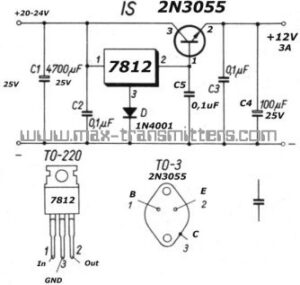Idiot’s guide to Power supplies
If you’re planing to power your transmitter from batteries than skip this section! You might want to read it to get an idea of what it takes to power transmitter off the mains voltage.
Most smaller home-built or low power transmitters need a good 12-15 volt, 2A (Minimum) to 10A (stronger 50W or 100W transmitters) stabilised mains power supply. Note stabilised was printed in bold type, meaning output voltage is regulated and stabilised to specific voltage with minimum noise or fluctuation. The noise can usually be heard as a hum (50/60Hz). If switching power supply is used noise can appear at the switching frequency and produce weird results when mixing with other signals in the transmitter.
Wall-wart types are sometimes not of stabilised type. Worst can output even 20V when in load-free mode and only go down to rated 12V under load. This is not what you want to use as it may damage your transmitter and will definitely present as a strong 50/60Hz hum on your signal from the lack of proper stabilisation. Short circuit protection is useful but not mandatory. A fuse serves well instead of protection and you should definitely use one. They cost 5 cents and a final RF transistor can cost you more than 100 US$/Euro.
Adjustable output voltage gives you an additional feature, you will be able to change your transmitter’s output power by changing voltage of your power supply. Not bad. You can sometimes squeeze more power out of your transmitter if you raise voltage over rated voltage for your transmitter just a little bit. But be careful, this is likely to destroy your output transistor, make some electrolytic capacitors blow up or cause excessive heating. MAXPRO exciters can take up to about 15.5V max before damage occurs.
Importance of proper power supply is often underestimated. Poor power supply can cause several serious problems; add hum to your signal, cause interference to your neighbours (typical for AM systems where RF leaks into power lines), low current rating, unstable operation under RF field etc. Complicated laboratory power supply units with lots of poorly shielded electronics are often susceptible to RF fields meaning they can uncontrollably raise their output voltage or short-circuit protection can trip when the current is not even reaching 10% of the limit. A good power supply for transmitters should be RF shielded.
Acceptable units are nowadays available at bargain prices, online stores such as Mouser or Digikey have them, as well as ham radio stores and ham fests. We sell a number of models ourselves here. Low voltage 15V versions are available here. Stronger transmitters often operate from 48V or even 65V. Our strongest mains power supply can power up to about 2000W FM transmitter. If you prefer to build your equipment by yourself get your soldering irons and check out these projects below. Always observe safety rules when handling mains voltage, mistakes can be lethal!
Adjustable 1A power supply
This is a simple variable output power supply. Now, left of this circuit would be standard line voltage transformer (110-220/18V) and a standard rectifier block with smoothing caps (10000uF or more). The heatsink of the 317 regulator must be isolated from the ground (aluminium heatsink).

3A 13.8V fixed-voltage power supply;

This is a pretty strait-forward circuit. You might need to bypass C5 with a bigger capacitor (10-100uF). Diode D makes up for the BE loss of 0.7V of the 2N3055 transistor. If you need higher voltage, use 7815 instead of 7812 and connect pin 3 directly to ground. This will give you 14-14.3V on the output. I built several power supplies like that for my CB/ham stations and they work very well. Of course you have to add mains transformer and rectifier bridge + smoothing caps, just like above. Caps should be as big as possible (20000uF or more).
28V high-current power supply for 40-200W RF power amplifiers;

This design is from the ARRL handbook 2005, we recommend this book to anyone as it covers all aspects in RF design including antennas, transmitters, basic electronics, filters, amplifiers and others. This power supply is very convenient for 40-200W RF amplifiers which often operate from 24V. Check ARRL handbook for PCB layout and additional details. We even have a link to this book in our Recommended reading section.
Discuss this article in our Forum!
